GARY BECK Q & A: SEATTLE RACING ICON SHARES HIS MEMORIES
Thu, 2011-08-11 21:30
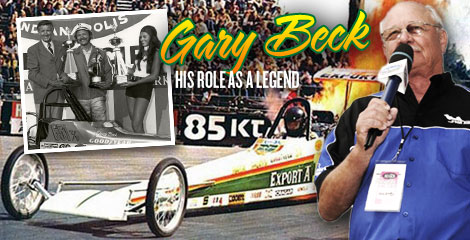 Gary Beck, honored as the NHRA Legend in his native Seattle this past week at the O'Reilly Northwest Nationals, spoke with Competition Plus about building the Space Needle and his own drag-racing career. Find out why he drove his Beck & Peets Export A Top Fuel Dragster around a road course and a circle track, how everybody thought he's a Canadian citizen, who was his classmate all the way through school, and who was sniffing oil and how that affected him.
Gary Beck, honored as the NHRA Legend in his native Seattle this past week at the O'Reilly Northwest Nationals, spoke with Competition Plus about building the Space Needle and his own drag-racing career. Find out why he drove his Beck & Peets Export A Top Fuel Dragster around a road course and a circle track, how everybody thought he's a Canadian citizen, who was his classmate all the way through school, and who was sniffing oil and how that affected him.
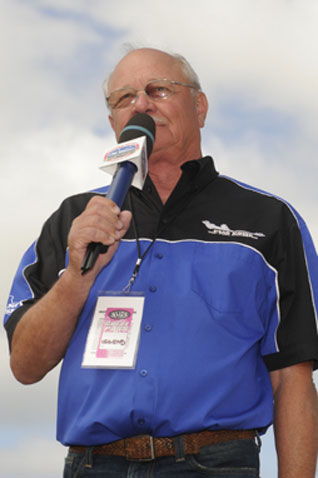
NHRA.com
CP: You're a racing icon in Seattle, but you’re identified with a Seattle icon -- the Space Needle. You helped build the Space Needle, didn't you?
GB: I did work on the Space Needle. It had to be in 1961. I was in the masonry business as an apprentice bricklayer. My uncle, who I worked for, had the job. I was up in the eye of the Space Needle, where the washrooms and the elevator shafts are. We rode that construction elevator up and down. It was 20-by-20-foot cage -- scared me to death. It was something.
And I was at Pacific Raceways on opening day. I was here at the first race, worked the tech line in the staging lanes. And I raced here many times. My son is racing here. He's got the Super Comp car. We've been to Sonoma [for the national event, the FRAM-Autolite Nationals] and the divisional race, and we'll be back in Seattle in two weeks for the divisional race.
CP: How does it feel to be an NHRA drag-racing legend?
GB: It's nice to be honored. That Legends program is nice. Don Garlits and Shirley Muldowney, I raced them. They beat me and I beat them through the years. I had great rivalries with both of them. Don Prudhomme and Roland Leong, I did not race against those legends. Warren Johnson's in there. I've known Warren for a long time. So it’s a nice group of people.
I get the [NHRA Legends] pass. Everywhere I go, nobody understands this pass: 'I never saw one of those before. What do you get?' Well, I think they’re supposed to let me in. They issued 50 for the top 50 drivers, but about 20 are deceased. So there's only about 30 of these passes out there, so you’re not going to see them very often.
It's fun. It's kind of cool.
CP: When you won the 1972 U.S. Nationals -- in your first Top Fuel event, no less -- people thought you came out of nowhere. But you hadn't really, had you?
GB: My professional career started in 1972, but I started drag racing in 1960 in the sportsman ranks. When I did win in 1972, in the Top Fuel car, I was the 15-year overnight success at Indianapolis. I made a lot of runs in Division 6. In 1968 and 1969, my partner and I won the Super Eliminator in Division 6. So we did a lot of racing in the Northwest. I had run 200 miles an hour in a Super Gas car in '69. So when I took over the Top Fuel car, it was a fairly easy transition.
CP: You have the distinction of driving your dragster around Mosport International Raceway near Toronto and again at Delaware Speedway, a banked oval short track near London, Ontario. Those were publicity stunts for your sponsor, Export A, right? What was that like?
GB: When we were sponsored by Export A, the Canadian cigarette company -- that was 1974-75 -- we did a lot of promotions across Canada. One was at Mosport, outside of Toronto, when NASCAR was there. We did an exhibition lap. The dragster is so fast and the groove is so good. Every time you'd stand on the throttle, it would hike the front end up. You'd go and you'd slow it down . . . turn and go, turn and go. I made a lap all the way around Mosport, which is a [2.459-mile] track.
They timed me, but I didn't know they were timing me. And I stopped in front of the grandstands and waved to the people, made another run down the back straightaway, I pulled the parachutes about three-quarters of the way around and dragged them around to put on a show. My time was only a few tenths off what the NASCAR [cars] were running that day. But the dragster's so fast. If I had any idea it was that close, I would have run a time faster than NASCAR. I didn't realize it was going to be that close. So that was fun.
The other was at London, on a circle track. We were going to do a fire burnout and go around and do a lap. It was at night. We start the car. We do this fire burnout in front of the grandstands. They turned the lights out in Turn 1! I can't see nothin'! I give it a little throttle so that the header flames come back up so I can see around the corner. I get around Turn 2 and they turn the lights back on. I stand on the throttle and it picks the front end up and wheew -- down [the track] we go!
They park us in there with all the other cars, but nobody hardly talks to us drag racers. But after we run the car, they were all over. It was a lot of fun.
CP: So by the time you got cranked up, corporate sponsorship had become an essential?
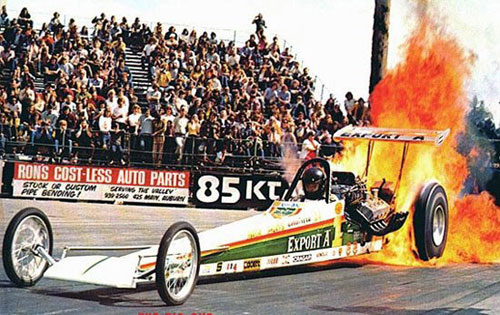
GB: In 1972, the car was sponsored by Ray Peets, who I ended up partners with. This was Reliable Engine Services out of Edmonton. He ended up purchasing the team, and Ray promoted the Export A sponsorship. We sold the program to 'em. That put us in the corporate world in 1974. We did lots of things with them across Canada. They had marketing people who traveled with us. We did burnouts in downtown Vancouver and Calgary. In 1974, we won the championship, and they hardly knew what to do with us. We'd only been there a year and already they had a world champion!
We had a program for the '76 season on the table with them. And the Canadian government came down on cigarette advertising and the whole marketing department disappeared. In two weeks there wasn't a person to answer the telephone. Then we were out of a sponsor. It took us a few months. That's then Thrush came in. That's the Canadian muffler company. We ran with them '76, '77, '78, '79. So that was quite a program, also -- not as large as the cigarette company, but it was good program. We weren't the first but one of the first teams that had a corporate sponsor like that.
CP: And that was back when corporate involvement didn't cost nearly as much because of the smaller schedule.
GB: It started out there were only six races. Then it was eight, and then it was 12 for a long time. When I stopped professional racing, it was like 18. Then it was 24. That's a lot of racing . . . and bigger budgets.
CP: The NHRA covers more markets and stops in all corners of the country now.
GB: That part of it is certainly different, but it’s still the same: You have to race your cars on Sunday.
CP: The cars themselves are completely different, too.
GB: They're so powerful these days. They're more than twice the horsepower we had, maybe three times.
CP: But what you had was the cutting-edge technology of the day.
GB: Absolutely. Back in the '70s, in hooking up with Ray Peets and Reliable Engines, it was what he did: build motors. The engine of choice out here is the late-model Chrysler Hemi and cubic inches is always the deal. We always had bigger motors than everybody else. As soon as they found out what we had, we'd build bigger and better. They'd copy. We'd move on. So we were always ahead of them. Now there's a limit, so everybody's the same today. They juts have to figure it out.
That kept us performing well. We had some great drag races. My first encounter with Don Garlits was in 1973. If you'll recall, I won the 1972 U.S. Nationals but the Pro Association [Professional Racers Association] went to Tulsa. They were mad at NHRA. So they say, 'Well, Gary's deal . . . All the guys weren't there.'
Well, in '73, back in Indianapolis . . . I forget where he qualified, but I was in the top half (No. 1) and Garlits was in the bottom. And he said, 'I did that on purpose.' Well, you can't really do that. That's just the way it worked out. We raced each other first round. Just beat him by a little bit. He got out of his car and came over and said, 'Nice top-end charge.' His car was fast, but ours was a little better that day.
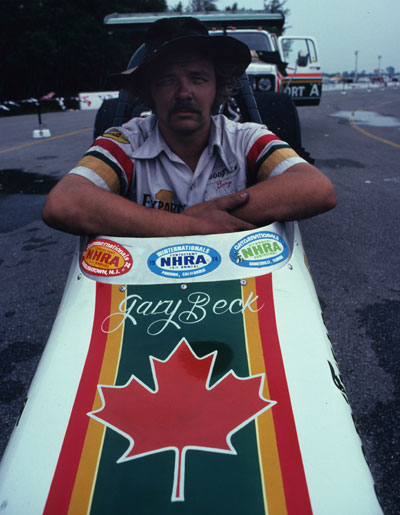
CP: That probably took a lot for him to concede to you.
GB: Oh yeah. He hated us. That's just the nature of it.
CP: A decade ago, in 2001, Dick La Haie and Don Prudhomme were yukking it up in Las Vegas about the old days when no one was friends with each other. La Haie said about "Big Daddy" and Shirley, "We didn't like them then, and we don't like them now." Said Prudhomme, "For sure, we didn't like Garlits, and Garlits didn't like us. And Shirley hated everybody." She said that's not true of her.
GB: She had a love-you-or-hate-you mentality. There was nothing in between. She has chewed on me like nobody else has. One time in Columbus, Ohio, I was in the grandstands, just watching, checking the track out. She sees me up in the grandstands and she come marching up and pokes her finger in my chest and saying, 'You're taking food out of our mouths.' She had match-raced Don Garlits at Cayuga many times, and I took her spot. I would go there and race Garlits. I like to think I'm more on the good side now, but I was on the hate side that day.
CP: Well, Shirley looked at it that way, as a business. Unlike all the racers today who congratulate each other at the top end, she said she didn't believe in patting on the back the guy who just beat her, because he took money out of her pocket. Do drivers today not rely on those earnings as much as you did?
GB: There are only three ways to fund a race car: sponsor money, prize money, and your own money. That's the only way you can do it. I stopped [racing on] my own money a long, long time ago. So that's the budget: sponsor money and prize money. That's what it is. In my era, you had to have a good year for the prize money to be 20 percent. I would imagine it’s in the same range, percentage-wise, today. It takes $3 million to race those cars.
CP: Racing, in general, seems like a non-profit proposition many times.
GB: Teams are making money. The top teams certainly make money. Their books are balanced. There are teams out there struggling, too. They're surviving.
CP: Even if it doesn’t pencil out, the struggling racers seem to come back for more. Is that crazy?
GB: It's an interesting way to make a living. Drag racing has been very good to me, the 20 years I did it professionally and even after that as I phased out. I went to Australia with the Top Fuel car and ran down there. It's taken me all over this country and Canada, everywhere -- mostly on the freeways. I've been to a lot of places a lot of other people didn't get the opportunity to go. It's a lot of fun.
CP: Racing in the Northwest was its own subculture, wasn't it?
GB: It was a tough area up here, a lot of Top Fuel cars. Jerry Ruth, he never won a series championship, but he won in '73, when it was the invitational at Amarillo [Texas]. He beat me in the final So that's two Northwest cars in the final round of what then was the championship. And Rob Bruins [of Bremerton and Federal Way in Washington] won with Gaines Markley.
Gaines and I went all through school together, from first grade through high school. We were partners in a gas dragster, but we were never partners in Top Fuel. So I won a championshi in Top Fuel. And Gaines won with Rob Bruins. We went to Daniel Bagley Grade School in North Seattle, John Marshall Junior High in the Ravenna area district [of Seattle] and Lincoln High School. How many times can you say you had two Top Fuel champions who went all the way through school together from the first grade?
CP: So you grew up in Seattle. Is it time to end the myth that you're Canadian?
GB: I married a Canadian. We had a Canadian racing team. I'm not Canadian. I never said I was Canadian. People told me I was Canadian. I certainly have a Canadian background in racing. Ray and I were inducted into the Canadian Motorsports Hall of Fame in 1999 as a team. I'm the only U.S. citizen in the Canadian Motorsports Hall of Fame.
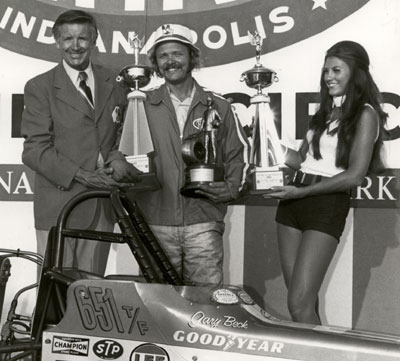
CP: Drag racing spends a lot of time looking at its past. How do you see the future of the sport?
GB: It's hard to say, but it looks pretty strong to me. You can always blame the economy for the bad times, but there's always a group of good cars and a group of cars in the back of the field. That hasn't changed. I would imagine the future's fine.
CP: Don Prudhomme once said that racers loved the trophies, and Greg Anderson said racers would keep coming back, even if the money disappeared completely. Could you see that happening?
GB: The money is important. But the thrill of victory is still the thrill of victory.
CP: Are you enjoying sportsman racing again?
GB: I enjoy racing with them. My two sons are there. I race with my older son, Steve, and my younger son, Randy, is with us. I enjoy racing with 'em in Super Comp. I have a niece, Cami Beck, who races Jr. Dragster. She's won a division race in Bakersfield, and she's good. The line now is that there are two Becks driving dragsters today and I'm not one of them.
CP: How did you know you were suited for racing? How did you know that you wanted to do this and not stick with construction?
GB: In my family, we were all construction people -- my grandfathers, my dad. People ask, 'How did Gary get involved in race cars?' I was the only one initially. My mother, who passed away a couple of years at age 91, when she was 87, we were talking about how did it all happen? And she said, 'I figured it out. When I was pregnant and I was carrying Gary, I craved oil. I sniffed oil. And that's what got him going in automotive things. Isn't that something? At 87 years old she came up with that.
CP: Do you think that's true?
GB: With my mother? Absolutely!

Categories:



